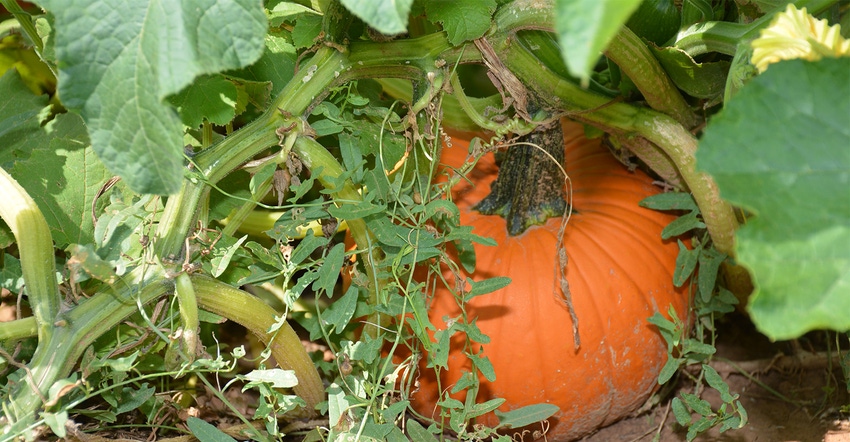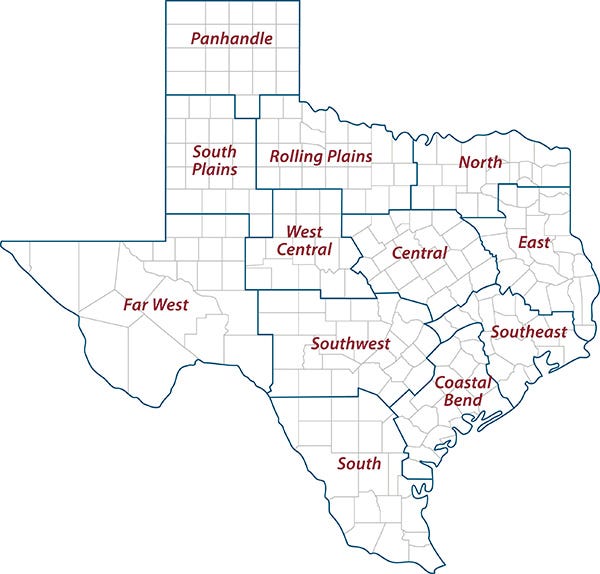
Texas’ pumpkin growers expect a below-average harvest this season as they dealt with early-season rains and extreme heat and drought through the summer months.
Mark Carroll, Texas A&M AgriLife Extension Service agent, Floyd County, said heavy spring rains in May and June delayed planting. Some fields had to be replanted due to poor conditions.
Fields that did emerge faced tough growing conditions as the weather turned hot and dry, Carroll said. The majority of pumpkin fields in Floyd County are drip irrigated, but the heat and lack of rain took a toll on vines.
In recent weeks, however, heavy rains have impacted harvest in some areas, he said.
“The rainfall impacted establishment early and then they were dealing with extreme temperatures and drought until the last few weeks,” he said. “We received about 3.5 inches a couple weeks ago and another seven-tenths of an inch to 2 inches last week. So, it’s been from one extreme to the other for growers.”
Fall market
Producer Jason Pyle, of Pumpkin Pyle in Floydada, said harvest was slowing at this point. He estimates his yields are 30 percent to 40 percent below average.
Pyle said his vines lost much of their first fruit sets due to extreme heat.
“The quality is good, but the numbers just aren’t where they usually are,” he said. “We planted a lot more acres this year, and I am glad we did.”
Pumpkin producers like Pyle hope to capitalize on Halloween, fall decorations and holiday cooking each year. Harvest typically begins around late August so producers can meet orders. Pyle expects his vines to produce pumpkins up to Halloween this season.
He suspects growers around the country had a difficult year as well because he is receiving orders from the northern U.S., California and East Coast.
“I don’t know if it was the hurricanes on the East Coast, but we are getting orders from places we typically don’t supply,” he said. “We typically serve Oklahoma City and Dallas markets, but we’ve been getting calls from all over the place. Something is going on.”
Pyle said his prices have leveled off despite difficulties and demand from other markets.
“I don’t know if this season’s conditions are affecting retail prices, but my prices stayed the same,” he said.
AgriLife Extension district reporters compiled the following summaries:

CENTRAL: Conditions were very dry. Grasses were wilting, and pastures looked stressed. A front delivered cooler temperatures district-wide and up to 1 inch of rain to a few areas. Producers were trying to get wheat in the ground as fast as possible for winter grazing. Livestock were in fair condition. Light shower brought very little rain relief. Counties reported short to very short soil moisture levels and poor rangeland, pasture and crop conditions.
ROLLING PLAINS: Producers continued to plant wheat. Cotton producers began to spray boll openers and defoliants on early and mature cotton. Cattle were in good shape. Some ranchers started supplementing cattle with protein cubes. Fall weaning began.
COASTAL BEND: Hot temperatures and some isolated showers were reported. In northern parts of the reporting area, cotton harvest continued with an estimated 10% of the crop remaining. Fieldwork including stalk destruction, disking and putting up rows continued. Gins continued to work through this year’s cotton crop, and some modules have not yet been picked up by gins. Pastures that received rain were growing and should get another hay cutting before frost. Armyworms were reported in some areas. Some fall brush control applications were made. Cattle remained in good condition, and inventories were steady. Supplemental feeding continued where needed.
EAST: No report.
SOUTH PLAINS: Subsoil and topsoil moisture levels were high due to constant rainfall. Rainfall ranged from 0.7 of an inch to 7 inches. Cotton harvest was delayed, and defoliated fields will likely need to be sprayed again for re-growth. Soils were starting to dry enough for harvest to resume soon. Pumpkin harvest will finish when fields dry enough. Winter wheat was emerging well with the recent moisture. A few sorghum producers were defoliating fields, and others were waiting for the plants to mature. Pasture and rangeland were performing well. Cattle were in good condition.
PANHANDLE: Conditions were wet with reports of 4-12 inches total rainfall throughout the district. Temperatures fell. Pastures and rangeland were in very good condition due to the rains. Winter wheat was mostly planted before the rains. Cotton was in fair to good condition. Sorghum and corn were in good condition throughout the district. Soybeans in northern parts of the district were in good condition.
NORTH: Soil moisture was mainly short across the district with some counties reporting adequate levels. Temperatures were high for this time of year and ranged from the mid- to high-90s. Sporadic rain was reported. Wheat farmers were busy in the field, but most were having to replant due to sorry stands or no stand at all. Some drowned out, some were hit by fall armyworms, and then a lot of wheat was crusted over and prevented it from emerging. Double crop soybeans were just about ready to harvest for most, and some harvested fields yielded around 15-20 bushels per acre. A lot of the early beans were put into silage which made around 3-4 tons per acre. Producers were still making hay, and stockpiles were high. Very few producers had weaned their calves because they were utilizing all the grass to put more pounds on calves and were hoping market prices would go up some. Some stock tanks were beginning to shrink. Cattle producers were supplementing poor pastures with hay and feed. Fall armyworms were hitting most fields and pastures pretty hard, and producers were busy spraying to control them.
FAR WEST: High temperatures were in the low-90s with lows in the low-60s. Storms brought rain, thunder, lightning, and flash floods with reports of 0.96 to 2.3 inches of rain. Evenings were cooler, and shorter days were helping conserve soil moisture. Growers may face an early frost according to some meteorologists. Cotton harvest was picking up. Upland cotton was beginning to open more bolls with each passing week. Dryland cotton was being stripped quickly with reports of yields much lower than expected. Irrigated cotton harvest should start soon. Many alfalfa and Sudan grass fields were cut, which dropped the quality and price. Pawnee pecan harvest should have started, but many pecan orchards were not prepared for harvest due to rain. Pecan trees were showing heavy loads, as well as nuts, were finishing for the year. Rangeland conditions were poor, and livestock needed supplemental feed. Wildlife were grazing along roadsides more and more. Ranchers were considering supplemental feed sources and options for fall and winter.
WEST CENTRAL: Conditions were warm and dry. Cotton was in mostly fair condition. Boll size and quality were becoming a concern for many producers. Some cotton was being released by crop insurance and destroyed. A few producers began to defoliate. Harvest was expected to begin within the week. Winter wheat planting began. Many producers were dry planting. Rangeland and pasture conditions were fair to poor. The market opened with steady prices after increases last week on most calves and yearlings. Stocker and feeder steers and heifers sold steady. Choice bred cows sold $25 to $50 higher per hundredweight.
SOUTHEAST: Fields were still very wet. It appeared some second rice crops might be harvested soon. Pastures in Grimes County were extremely dry due to a lack of rain and continued extremely high temperatures. Livestock were also stressed. Cooler temperatures and rain were expected. Jefferson County received 43 inches of rain in 24 hours, which damaged rice crops, flooded hay stocks and stressed livestock. Rangeland and pasture ratings were excellent to very poor with good being most common. Soil moisture levels ranged from adequate to very short with adequate being most common.
SOUTHWEST: Conditions remained very dry with a few counties reporting spotty showers with amounts ranging from a trace to almost 1 inch. The first northern front blew in with cooler mornings and warm afternoons. Preparation for wheat and oat plantings began. Pastures needed more rain, and supplemental feeding of livestock was ongoing with some producers looking to purchase hay. Pecan harvest began. Deer counts showed reduced herds due to the anthrax outbreak earlier this summer. Some areas reported 80 percent reduction in population. Livestock were in fair condition.
SOUTH: Northern, western and eastern parts of the district reported warm to hot weather with short to very short soil moisture levels. Mild weather and short to adequate soil moisture levels were reported in southern areas of the district. In Zavala County, a large cotton crop was keeping both cotton gins in the county very active with one operating around the clock. Cotton harvest was almost complete in Frio County, and peanut digging started. Sorghum silage and Sudan hay was being cut and baled. Livestock supplemental feeding continued. Some producers were hauling water for livestock. Ranchers were reducing herd numbers for winter. Rangeland and pasture conditions were poor in many areas but improved in areas with moisture. Wheat planting started. La Salle County reported scattered showers with rain amounts of 0.5 of an inch to 1 inch. Central parts of Live Oak County reported 2.5-4 inches for September, but northern areas didn’t receive half an inch of rainfall for the month. Irrigated crops like Coastal Bermuda grass and vegetables were at the end of their season. Cabbage made good progress. Some irrigated wheat emerged while dryland producers were waiting for moisture. Spinach planting continued, and short-day onion planting was also active.
Source: is AgriLife TODAY, which is solely responsible for the information provided and is wholly owned by the source. Informa Business Media and all its subsidiaries are not responsible for any of the content contained in this information asset.
About the Author(s)
You May Also Like




